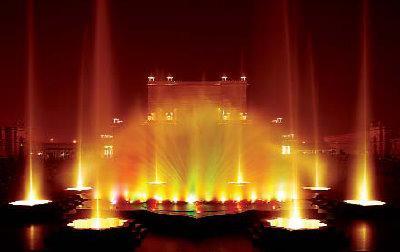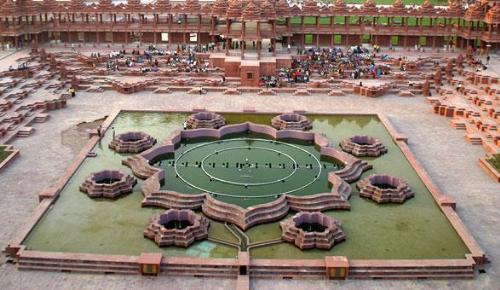 Akshardham means the eternal, divine abode of the supreme God, the abode of eternal values and virtues of Akshar as defined in the Vedas and Upanishads where divine bhakti, purity and peace forever pervades.
Akshardham means the eternal, divine abode of the supreme God, the abode of eternal values and virtues of Akshar as defined in the Vedas and Upanishads where divine bhakti, purity and peace forever pervades.
It is built along the river Yamuna and lies over an area of around 100 acres with beautiful gardens, water fountains and carved pavilions. The temple took complete two years for completion and a hefty sum of rupees was invested in the construction. According to estimates, around 2 billion was spent in the construction of this masterpiece which indeed depicts the great Hindu religion.
Akshardham was consecrated on 6 November 2005 by Pramukh Swami Maharaj, and ceremoniously dedicated to the nation by the President of India, Dr. A.P.J. Abdul Kalam, the Prime Minister, Manmohan Singh, and the Leader of the Opposition in the Indian Parliament, Lal Krishna Advani, with the presence of 25,000 guests.
The building had been planned since 1968 as a vision of Yogiji Maharaj. Yogiji Maharaj, the spiritual head of the BAPS Swaminarayan Sanstha at the time, expressed his desire for wanting a grand temple built on the banks of the Yamuna river, to two or three devotee families of Bhagwan Swaminarayan that resided in New Delhi at the time. Attempts were made to start construction, however little progress was made. In 1971, Yogiji Maharaj passed away.
In 1982, Pramukh Swami Maharaj, Yogiji Maharaj's predecessor as the spiritual head of BAPS, started to continue fulfilling the dream of his guru Yogiji Maharaj and prompted devotees to look into the possibility of building the temple in Delhi. A request for the plan was put forward to the Delhi Development Authority (DDA), and several different places were suggested, including Ghaziabad, Gurgaon, and Faridabad. Pramukh Swami Maharaj stood firm in following the wishes of Yogiji Maharaj to build a temple on the Yamuna.
In April 2000, after 18 years, the Delhi Development Authority offered 60 acres (240,000 m2) of land, and the Uttar Pradesh Government offered 30 acres (120,000 m2) for the project. Upon receiving the land, Pramukh Swami Maharaj performed puja on the site for success in the project. Construction on the temple began on 8 November 2000 and Akshardham was officially opened on 6 November 2005, with the building being completed in two days short of five years. On 17 December 2007, Michael Whitty, an official world record adjudicator for Guinness World Records, traveled to Ahmedabad, India to present a new world record to Pramukh Swami Maharaj, the spiritual leader of BAPS Swaminarayan Sanstha, for the Akshardham complex.
The record was presented for Akshardham as the World’s Largest Comprehensive Hindu Temple. The certificate states,
"BAPS Swaminarayan Akshardham in New Delhi, India, is the world's largest comprehensive Hindu temple. It measures 356 ft (109 m). long, 316 ft (96 m). wide and 141 ft (43 m). high, covering an area of 86,342 sq ft (8,021.4 m2). The grand, ancient-style, ornately hand-carved stone temple has been built without structural steel within five years by 11,000 artisans and volunteers. His Holiness Pramukh Swami Maharaj, revered spiritual leader of BAPS, consecrated the temple on 6 November 2005. Akshardham showcases the essence of India's ageless art, borderless culture and timeless values.”
Three months of research took place before the presentation of the award, poring over the extensive architectural plans of the Akshardham and also those of other temples of comparable size, visiting and inspecting the site.
Akshardhaam Temple of New Delhi is built in an architectural style similar to that of the Akshardham temple of Gandhinagar in Gujarat, India. Its construction is based on the ancient Sthaapatya shastras of India and it is built without steel, entirely out of sandstone and marble.

Approximately 234 ornate pillars, floral motifs, arches, exquisitely carved pavilions, 9 ornate domes, 20 quadrangle shikhars, a spectacular Gajendra Pith (plinth of stone elephants), adorn this architectural wonder. There are 20,000 statues inside Akshar Dham Mandir of Delhi of India's great sadhus, devotees, acharyas and divine personas. Other features of the Akshardham Temple are an IMAX theatre, a Swaminarayan temple, and an elaborate musical fountain. The area around the temple building has been converted into manicured lawns with beautiful water fountains.
The main features of Akshardhaam temple are:
Sahajanand Darshan (Audio Animatronics Shows) – It conveys the timeless messages of Indian culture featured through the life of Bhagwan Swaminarayan. The principle theme of sculpting one’s life for happiness, success and peace of mind is portrayed in this exhibition. The exhibits portray the messages of ahimsa, endeavor, prayer, morality, vegetarianism, family harmony, etc. through fifteen 3-D dioramas and presentations from the life of Bhagwan Swaminarayan. Exquisite settings and statues in each diorama are brought to life through robotics, fibre optics, light and sound effects, dialogues and music; transporting the audience to 18th century India.
Neelkanth Darshan - An epic period film featuring an exciting and inspiring pilgrimage of Neelkanth Varni, a child-yogi, of 18th century India. This unique period film, Neelkanth Darshan, was shot in the icy peaks of the Himalayas in the north to the pristine shores of Kerala in the south. The large format film depicts India’s holy places, festivals and spiritual traditions on a giant screen that is over six stories high. Neelkanth Darshan is the first ever wide format film filmed in India and produced by an Indian organisation.
Sanskruti Vihar (India's Glorious Heritage) - A 12-minute spectacular boat-ride experience of the 10,000 year old India’s glorious heritage, which savor the world’s oldest vedic village life and bazaar, sail through Takshashila – the world’s first university, journey through the labyrinth of ancient discoveries and inventions by the great rishi-scientists of India.
Yagnapurush Kund - To appease the deities of earth, water, fire, air, etc, India’s great sages and rishis established the yagna tradition. They chanted mantras, offered grains and ghee in a sacrificial fire (yagna kund). The Yagnapurush Kund is a fascinating combination of a Vedic yagna kund and a musical fountain. It is the world's largest yagna kund measuring 300' X 300' with 2,870 steps and 108 small shrines. In its center lies an 8-petaled lotus shaped yagna kund designed according to the Jayaakhya Samhita of the Panchratra scripture. Its perfect geometric forms testify to ancient India's advanced knowledge in mathematics and geometry. At night the center comes to life with a colorful musical water fountain that echoes the Vedic sentiments of India.
Bharat Upvan - Bharat Upvan exudes a magnificent natural and cultural ambience through its manicured lawns, lush gardens and wonderful bronze statues of the great role models of India. India's child gems, valorous warriors, freedom fighters, national figures and great women personalities inspire visitors with values and pride for our great nation.
Yogihriday Kamal - This is a special lotus of auspicious sentiments. Every petal of Yogihriday Kamal reflects the auspicious sentiments of Yogiji Maharaj.


Akshardham Gandhinagar in Gandhinagar, Gujarat is the sister complex of Delhi Akshardham. The monument in Gandhinagar was also constructed by BAPS. Opened in 1992 amid fanfare, Akshardham Gandhinagar comprises a monument, exhibition halls, a vast colonnade, contemplative gardens, and a restaurant, much like the monument in New Delhi. The architecture and carvings of the monument in Delhi resemble those of the monument in Gandhinagar.
